Executive Summary Examples & Templates
When introducing your business to angel investors, stakeholders, and venture capitalists, they won’t want to sit through fifty pages explaining why they should work with you. A simple and effective way to present your business in a palatable way is to write an executive summary. This document can tell the potential investors what to expect from the meeting where you will discuss your business plan or investment proposal. It will summarize the reason for your project.
Have you ever prepared an executive summary? If not, the following guideline and Executive Summary Example should help you create a concise and compelling one.

What Is an Executive Summary?
An executive summary is a broad overview of a business document that tells the reader everything they need to know about a business plan or investment proposal. While the length and scope will often depend on the document being summarized, most executive summaries are about one to two pages long. Important documents that usually include an executive summary include:
- Project plans
- Business cases
- Project proposals
- Environmental studies
- Research documents
- Market surveys
Purpose of an Executive Summary
As mentioned, most lenders, executives, managers, and investors will not want to take time out of their busy day to read an entire novel-sized document. Still, they will want to know what your plan is about and why they should invest in or approve it. A summarized version of the plan – the executive summary – presents an analysis of all your arguments, funding considerations, and projected returns, among other key details. This is often enough to convince them to take a better look at your plan.
Essential Elements of an Executive Summary
A business plan consists of your company’s mission, vision, product or service description, brand identity, goals, target market, and financial projections. In turn, an executive summary should be a short version of your business plan. It should contain the following details:
- Your company’s name and office locations
- Mission and vision
- A brief history and company description
- An overview of your management, advisors, and employees
- A product or service description, including its niche market and competition status – how does it stand out from products from other companies?
- Company goals and objectives
- Startup financial budget and projected returns
- A review of how the reader can help you accomplish your goals
How to Write an Executive Summary
Most executive summaries have four main parts: the problem, the solution, the value of the solution, and the takeaway. The following step-by-step guide will help you flesh out these elements with information that your stakeholders want to know.
Step 1: Define the Pain Point
Start by defining the problem that your business plan or project proposal aims to solve. Include market research and customer feedback to back up your claims and explain why this problem is worth solving. How will solve it helps your target market? Why does it matter?
Step 2: Outline Your Solution
Next, explain your solution and convince the stakeholder that it is the right approach to the problem. Answer the question, ‘how will my product or service solve the problem?’ Once you have, support your solution with facts and figures.
Tip: At the time of writing an executive summary, you will often not have the complete map of your product or service and milestones. Rather than use this document to brainstorm, briefly tell the reader what you plan to do and back it with success-rate research.
Step 3: Expound on the Value of Your Solution
Now, go into detail about how the solution you have described will solve the problem you defined in step 1. Why is your solution important? What results will it yield? This is also where you should highlight potential returns, projected risks, and financial projections for the solution. You should also explain how it ties into your company’s mission, vision, and goals.
Step 4: Supply the Takeaway
Lastly, guide the reader to a takeaway by telling them what they should conclude from your executive summary. Think of this as one final chance to convince them to get on board.
Executive Summary Example
The following is an Executive Summary Example for the imaginary company: Green Future Ltd.
Company Mission
Green Future Ltd. provides green energy solutions to factories, industries, warehouses, and homes, allowing efficient functioning that is safe to both the user and the environment. Our mission is to help you watch TV, drive your tractor, and perform your manufacturing process without worrying about your health or those around you.
Company and Management
The Green Future Ltd.’s main office is located in Jersey City, New Jersey, with branches in Huntington Beach and Bayonne. It is owned and run by Holly Howard, Ph.D., an environmental engineer at MIT, and James Sutton, MBA, who has 30 years of experience in green solar energy solutions.
The company management consists of the two owners and a board of advisors that includes:
- Malcolm Right, CEO of Right Engineering Firm LLP
- Att. Grace Hawkins of the Law Offices of Grace Hawkins (Environmental Law)
- Hellen Irene of ABC Marketing and Accounting
Our Services
We cater to industries, companies, farms, and homeowners that would like to switch to more affordable, environment-friendly, and efficient energy sources and systems. Our services include:
- Solar panel installation
- Panel restorations
- Windmill constructions
- Biogas plant construction
- Bio-digester system installation
- Energy consultations
- Large scale green energy solutions
- Energy recycling
- Round-the-clock repair services
Recently, the call for industries to turn to green energy has become more prominent. More and more companies in New Jersey are looking for ways to optimize their energy use for more efficiency in industrial processes, a smaller carbon footprint, and affordable solutions. According to our market research, eight out of every ten business owners in Jersey City alone plan to switch to solar energy within the next five years.
Competitive Edge
Currently, there are five companies offering green energy solutions in New Jersey but none at our scale. Four of these businesses cater to small-scale farms and homes, while one only focuses on large plants. Green Future Ltd. emphasizes its all-size approach because our solutions can be up or downscaled to meet the needs of a single homeowner or multi-warehouse industry. Our technicians are also highly accredited and from prestigious engineering schools in the country.
Financial Projections
Our market research shows sales projections of $3.6 million for the first year and a steep 20 percent growth rate for the next four years.
Startup Requirements
Green Future Ltd will need $1.5 million in startup costs to finance this first year of operation. The owners have already invested $900,000 toward the capital.
Executive Summary Samples & Templates

An executive summary is a brief overview of a business plan or project proposal, usually found among the first pages of the entire document. It captures the reader’s attention and tells them everything they need to know about the company, your plans, and where they come in – so they can decide whether to invest in or approve your plan (project). If you are preparing to meet with potential stakeholders, this guide and the Executive Summary Example should help you capture and keep their attention.
How did our templates helped you today?
Opps what went wrong, related posts.

23+ Business Travel Itinerary Templates

Apology Letter For Bad Behavior – 7+ Samples & Formats

Restaurant Employee Evaluation Form

Peer Evaluation Form: Templates and Examples

Free Newspaper Templates

40 Free Event Program Templates

44 Open House Sign in Sheet Templates

22+ Free Packing Slip Templates
Thank you for your feedback.
- Paragraph Generator
- Cover Letter
- Authorization Letter
- Application Letter
- Letter of Intent
- Letter of Recommendation
- Business Plan
- Incident Report
- Reference Letter
- Minutes of Meeting
- Letter of Resignation
- Excuse Letter
- Research Proposal
- Job Application
- Acknowledgement
- Employment Letter
- Promissory Note
- Business Proposal
- Statement of Purpose
- Offer Letter
- Deed of Sale
- Letter of Interest
- Power of Attorney
- Solicitation Letter
16+ SAMPLE Startup Executive Summary in PDF | MS Word
Startup executive summary | ms word, 16+ sample startup executive summary, what is a startup executive summary, different types of startup executive summaries , basic components of a startup executive summary , how to write a startup executive summary , what are some examples of startup executive summaries, what are the fundamental elements of a startup executive summary, why are startup executive summaries essential for startup companies, what are the different kinds of startup businesses.

Startup Competition Executive Summary

Startup Clinical Program Executive Summary

Startup Costs Executive Summary

Startup Commercialization Executive Summary

Business Startup Executive Summary

Business Startup Development Executive Summary

Startup Pitch Executive Summary

Transportation Startup Executive Summary

Startup Fund Executive Summary

Basic Business Plan Startup Executive Summary

Startup Act Executive Summary

Startup Pitch Desk Workshop Executive Summary

Brain Startup Executive Summary

Startup Business Plan Template Executive Summary


Startup Business Idea Plan Executive Summary

Startup Sample Business Executive Summary

Startup Executive Summary
1. startup commercialization executive summary, 2. business startup development executive summary, 3. restaurant startup sample business executive summary, 4. healthcare startup clinical program executive summary, step 1: start with an interesting opening statement, step 2: describe the startup company, step 3: develop a market analysis, step 4: showcase your products and services, step 5: add financial details, projections and future plans, step 6: review, proofread and edit , share this post on your network, you may also like these articles, 12+ sample business invitations in indessign | vector eps | ai.

It is essential for you to have a well-developed business invitation if you plan to host or organize a business event. It is necessary for you to come up…
26+ SAMPLE Business Flyers in PSD | AI | PDF

Business marketing will require you to exert your efforts and use your time efficiently so you can produce and implement plans of action that can be useful for the…
browse by categories
- Questionnaire
- Description
- Reconciliation
- Certificate
- Spreadsheet
Information
- privacy policy
- Terms & Conditions
Executive Summary Examples for Business Plans, Project Plans, and Research Projects
By Kate Eby | February 8, 2024
- Share on Facebook
- Share on LinkedIn
Link copied
Executive summaries allow decision-makers to quickly grasp the key points of important documents and make decisions. We’ve collected a variety of executive summary examples and templates that you can use as models for your executive summaries.
Included in this article, you’ll find a business plan executive summary example , a project proposal executive summary example , a research report executive summary example , and more. Plus, learn how to fix common executive summary mistakes .
What Are the Main Components of an Executive Summary?
An executive summary is a concise overview of a larger document, report, or proposal. It gives high-level executives or decision-makers a quick understanding of the main points of a longer document without requiring them to read the whole text.
These are the components you might include in an executive summary:
- Problem Statement: Clearly state the problem or challenge the company, product, or project addresses.
- Key Proposition: Outline the proposed solution or key value proposition.
- Market Analysis: Summarize findings about the market, customer needs, or competition.
- Key Features and Benefits: Highlight the main features or benefits of the proposed solution or strategy.
- Financial Summary: Provide a snapshot of financial aspects, such as cost, revenue projections, or return on investment (ROI).
- Next Steps: Briefly describe the next steps or strategy for implementation.
Simple Executive Summary Example
The following simple executive summary presents a concise statement of key findings and links them directly to a strategic recommendation. It provides a clear snapshot of the situation and the proposed action, which is essential for an executive summary.
Problem Statement
Many small businesses struggle with inefficient inventory management, leading to lost sales and increased operational costs.
Key Proposition
Our company proposes an AI-driven inventory management system that automates tracking and forecasting, tailored for small businesses.
Market Analysis
Research shows a 40 percent increase in demand for automated inventory solutions in the small business sector, with a significant gap in affordable, user-friendly options.
Key Features and Benefits
The system offers real-time inventory tracking, predictive restocking alerts, and an intuitive interface, reducing inventory errors by an estimated 50 percent.
Financial Summary
Our projected development cost is five hundred thousand dollars with a break-even point in 18 months. The expected ROI is 200 percent in three years, tapping into a market with a potential revenue of five million dollars annually.
Development will commence in Q1 2024, with a pilot launch in Q3. Full market release is scheduled for Q1 2025, followed by targeted marketing campaigns and customer feedback integration for further enhancements.
Executive Summary Template
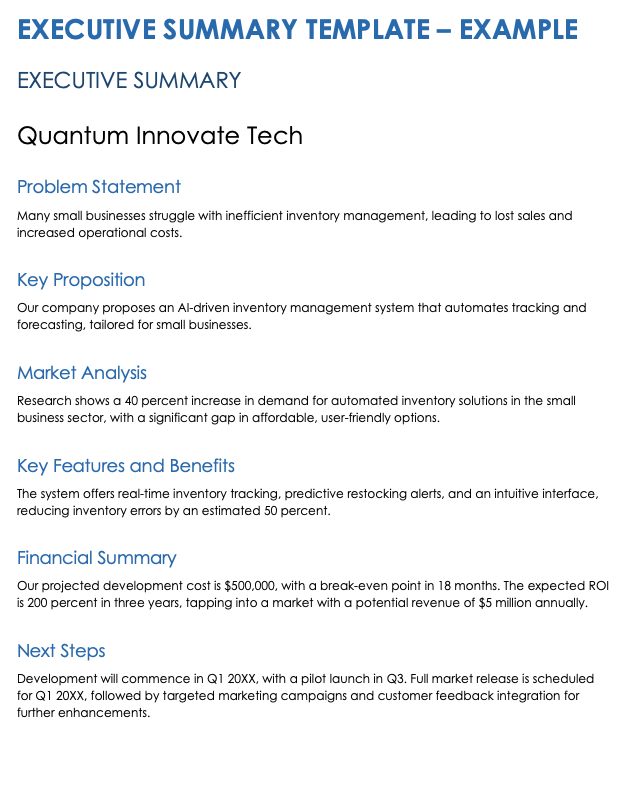
Download a Blank Executive Summary Template for
Microsoft Word | Google Docs
Download an Example Executive Summary Template for
Available in blank and example versions, this executive summary template guides you in succinctly presenting key information about your business plan or project to stakeholders. Simply fill in each section with relevant details to create a concise overview that highlights problems, solutions, market potential, product features, financials, and next steps.
Business Plan Executive Summary Example
Review the following example for a business plan executive summary of an eco-friendly transportation company. This example provides a clear, brief overview that is essential when you want to engage stakeholders and set the stage for more detailed discussions.
In urban areas, the lack of convenient, eco-friendly transportation options leads to increased traffic congestion and pollution.
GreenGo Mobility Solutions proposes a network of e-bike sharing stations, offering an affordable, sustainable, and flexible transportation alternative.
There is a growing trend toward eco-friendly transport in cities, with a 60 percent increase in e-bike usage. Surveys show high interest among urban commuters for more accessible e-bike options.
Key Features and Benefits
Our e-bikes are equipped with GPS tracking and easy-to-use interfaces. The bikes are designed for urban environments, offering a convenient and environmentally friendly commuting option.
The project requires an initial investment of two million dollars, with projected annual revenue of five million dollars by the third year. We anticipate a break-even point within two years, based on subscription and pay-per-use models.
Marketing Plan Executive Summary Example
In the following example, an executive summary outlines a marketing initiative within a company, detailing both the challenge and the strategic response. It provides a clear overview of the marketing plan’s objectives, actions, and expected outcomes.
We have seen a decline in new user adoption of our company's flagship software product over the past year.
Initiate a Revitalize and Engage campaign, focusing on updating the product’s user interface and enhancing customer engagement through social media and community building.
Competitor analysis and customer feedback indicate a need for more intuitive design and stronger community presence to attract and retain users.
The campaign will introduce a sleek, user-friendly interface and a robust online community platform, aiming to increase user engagement and satisfaction.
The campaign requires a budget of five hundred thousand dollars, with an expected increase in user adoption rates by 20 percent within the first year post-implementation.
Begin a UI redesign in Q2 2024, launch a social media engagement strategy in Q3, and roll out the updated product with community features in Q4.
Project Proposal Executive Summary Example
The example executive summary below demonstrates a well-structured project proposal that succinctly identifies a specific challenge and proposes an actionable solution. It provides a comprehensive snapshot of the project, including its rationale, expected benefits, financial implications, and implementation timeline.
Our current customer relationship management (CRM) system is outdated, leading to inefficiencies in sales tracking and client management.
We propose the development and implementation of a new, custom-built CRM system to streamline sales processes and enhance customer engagement.
Internal analysis indicates a 35 percent increase in process efficiency with a modern CRM system, while competitor benchmarking shows significant advantages in customer retention.
The new CRM will offer real-time sales tracking, automated client communication tools, and advanced analytics features, improving sales efficiency and customer satisfaction.
The estimated project cost is two million dollars, with a projected increase in sales efficiency by 50 percent and customer retention by 20 percent within two years.
Initiate the project in Q2 2024, with phase-wise implementation and employee training, aiming for full deployment by the end of Q4 2024.
Startup Executive Summary Example
Startups need to communicate their vision to potential investors and key stakeholders. In this example, an executive summary helps convey the startup’s vision with a concise summary of the business opportunity, unique selling proposition, market potential, and action plan.
There is a growing demand for sustainable and eco-friendly home cleaning products, but the market lacks options that are both effective and affordable.
EcoClean Innovations is a startup offering a line of environmentally friendly, biodegradable cleaning products made from natural ingredients, catering to eco-conscious consumers.
Market trends show a 50 percent increase in consumer preference for green homecare products, with a significant gap in cost-effective options.
Our products are non-toxic and competitively priced, and they have a minimal environmental footprint, addressing the need for effective and sustainable cleaning solutions.
We require an initial investment of one million dollars, projecting a 30 percent market penetration in the eco-friendly segment within the first two years.
Launch with an initial range of products by Q3 2024, followed by marketing campaigns targeting eco-conscious communities and online marketplaces.
Real Estate Development Executive Summary Example
In the following executive summary example for a construction project, the author outlines their vision for the Greenway Residential Complex. This summary captures the essence of the construction project proposal, presenting key information in a concise and structured format.
The growing urban population in Metro City has led to a shortage of affordable, eco-friendly housing options, resulting in increased living costs and environmental concerns. Key Proposition
Our project proposes the development of the Greenway Residential Complex, a sustainable and affordable housing solution. Utilizing innovative construction methods and eco-friendly materials, the complex aims to provide a balanced urban living experience that is both cost-effective and environmentally responsible.
Research indicates a high demand for eco-conscious housing in Metro City, with a market gap in affordable segments. Surveys show that young families and professionals are actively seeking sustainable living options that align with their environmental values and budget constraints.
- Sustainable design incorporating solar panels, rainwater harvesting, and green spaces
- Affordable pricing, targeting middle-income families and young professionals
- Proximity to public transportation and city centers, reducing commute times and the carbon footprint
- High-quality, energy-efficient building materials, ensuring lower utility costs and a smaller environmental impact
- Estimated project cost: Fifty million dollars
- Anticipated revenue from sales: Seventy million dollars, with a projected ROI of 40 percent over five years
- Funding secured from green building grants and private investors
- Finalize construction permits and approvals by Q2 2024.
- Begin construction in Q3 2024, with a projected completion date in Q4 2026.
- Launch a marketing campaign targeting eco-conscious families and professionals. Tip: In this example, notice how helpful it is to use bullet points to convey certain information. Using bulleted lists is a great way to organize and present information in an executive summary.
Construction Project Executive Summary Example
Construction projects have many moving parts, which means executive summaries need to capture a lot of information in a small space. Consider a construction-specific executive summary template to ensure that stakeholders are keyed into the most vital project information.
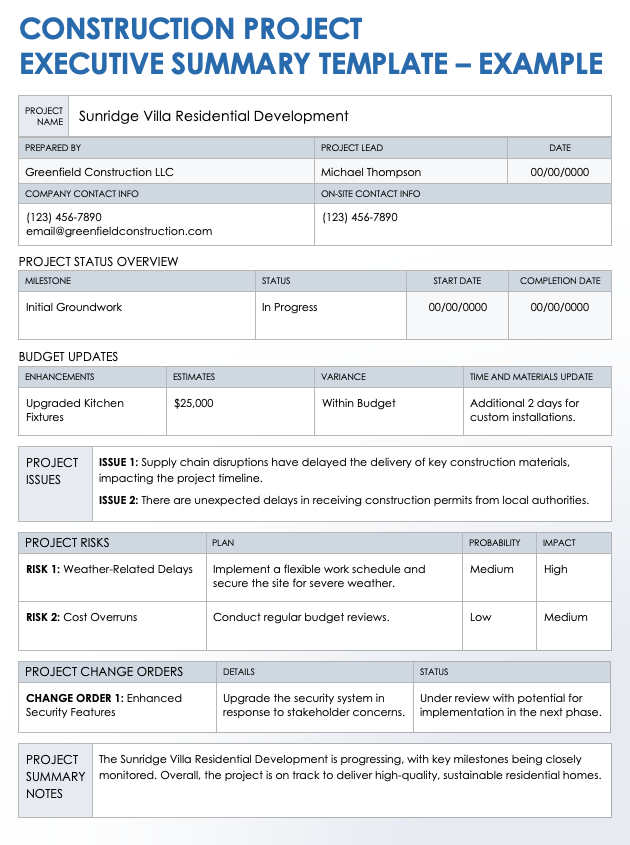
Download a Blank Construction Project Executive Summary Template for
Microsoft Word | Adobe PDF | Google Docs
Download an Example Construction Project Executive Summary Template for
Microsoft Word | Adobe PDF | Google Docs
This construction project executive summary template allows users to give a high-level overview of the key aspects of a project, such as status, risks, issues, and changes. Available in both blank and sample versions, this editable template condenses complex project information into an easily digestible format. To use it, simply fill in each section with relevant, concise information about the current state and progress of your construction project, ensuring it remains updated and reflective of any changes or developments.
Renewable Energy Initiative Executive Summary Example
A renewable energy initiative executive summary should highlight the project’s objectives, strategies, and potential impact, as well as its contribution to environmental sustainability. In the following example, the summary articulates the project’s vision and its alignment with global environmental goals.
The urgent need to address environmental challenges and the increasing global demand for energy underscore the importance of transitioning to renewable energy sources. The reliance on traditional fossil fuels is unsustainable and contributes significantly to climate change.
The SunWind Project is a pioneering initiative combining solar and wind power to create a robust and sustainable energy solution. This project aims to leverage the strengths of both solar and wind energy, ensuring a continuous and reliable power supply while significantly reducing carbon emissions.
The renewable energy sector is experiencing rapid growth, fueled by global environmental policies and a rising consumer preference for sustainable energy. This shift presents an opportunity for the SunWind Project.
The project is unique in its integration of solar panels and wind turbines, ensuring consistent energy production under varying weather conditions. This scalable approach is designed to adapt to increasing energy demands. By significantly reducing the carbon footprint, the project supports global environmental sustainability goals and has the potential to power thousands of homes and businesses.
The SunWind Project has an estimated cost of two hundred million dollars, with projected revenues from energy sales anticipated to be around three hundred million dollars over the next 10 years. This represents a potential ROI of 50 percent. The project is poised to benefit from green energy grants, government subsidies, and private investments.
Immediate steps include securing the necessary environmental permits and clearances. The construction phase, slated to begin in the second quarter of 2024, will focus on installing solar panels and wind turbines, with a goal to commence energy production by the end of 2025.
One-Paragraph Healthcare Executive Summary Example
An executive summary of a healthcare initiative needs to do the following: concisely identify a pressing healthcare issue, present a tailored solution with its benefits, summarize market needs and competition, and outline the financial viability and next steps.
In the following example, notice how an executive summary can capture all key elements in a single paragraph:
The HealthFirst Community Wellness Initiative addresses the critical problem of rising chronic illness rates in urban areas, focusing on diabetes and heart disease. Our comprehensive solution involves launching community health centers that provide preventive care, lifestyle education, and regular health screenings, as well as cater to the specific needs of urban populations. Market analysis indicates a significant demand for accessible healthcare services in these areas, with a lack of preventive and educational resources being a key gap. The initiative’s main features include state-of-the-art diagnostic tools, personalized health plans, and collaboration with local fitness and nutrition experts, offering benefits such as improved community health outcomes and reduced healthcare costs. Financially, the project is expected to be sustainable, with a mix of funding from public health grants and private partnerships. We are projecting a positive ROI within three years due to reduced hospital admissions. The next steps involve securing funding, establishing partnerships with local health professionals and organizations, and launching a pilot center in the downtown district, with a plan to expand to five more urban areas within two years.
Nonprofit Executive Summary Example
An executive summary for a nonprofit organization should communicate the essence of a project or initiative to donors and volunteers. It should concisely outline the organization’s mission, goals, and key solutions while also detailing strategies, actions, and their impact.

This executive summary example from Doctors Without Borders emphasizes the inadequacy of current Universal Health Coverage (UHC) agendas in meeting the needs of vulnerable populations. It then proposes six key recommendations to address these shortcomings.
This executive summary succinctly identifies the core issue — inequitable access to healthcare — and clearly outlines actionable recommendations. This document helps facilitate advocacy and policy change, which are central to this organization’s goals.
Research Report Executive Summary Example
An executive summary in a research report concisely presents the key findings, conclusions, and recommendations derived from a research project. It covers elements such as the project topic, background, research methods, and critical insights, tailored for quick understanding and decision-making.
In this real-world exampl e from the ASPCA , the executive summary details a study showing that veterinary hospitals’ proactive discussions about pet health insurance positively impacted hospital revenue and increased patient visits.
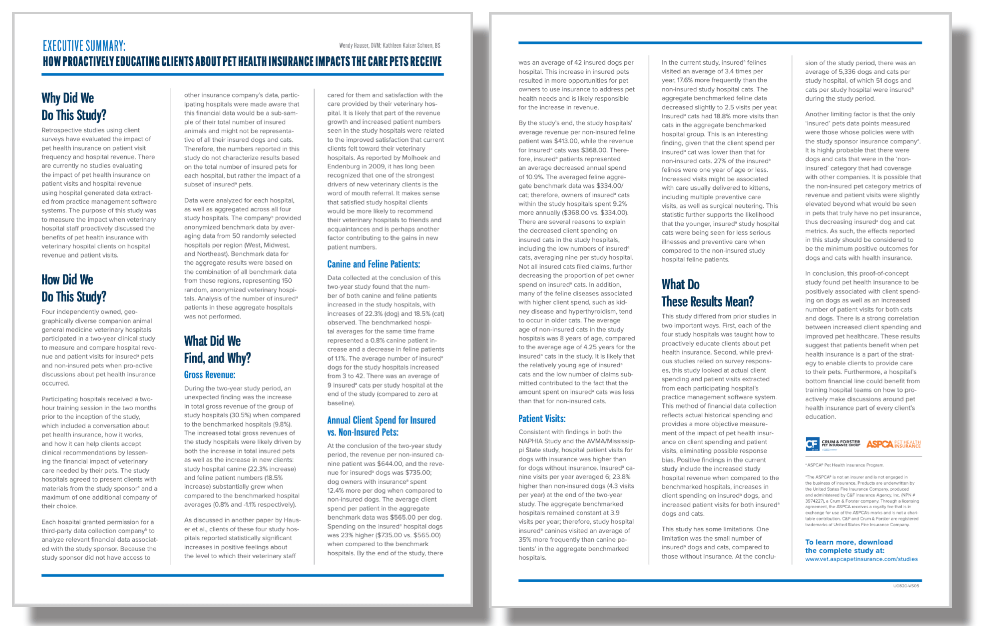
Notice how this summary concisely outlines the study’s purpose, methodology, and significant findings, providing a clear overview for readers. In addition, it highlights the study’s relevance and implications for veterinary practices, emphasizing the practical benefits of educating clients about pet health insurance.
Research Report Executive Summary Template
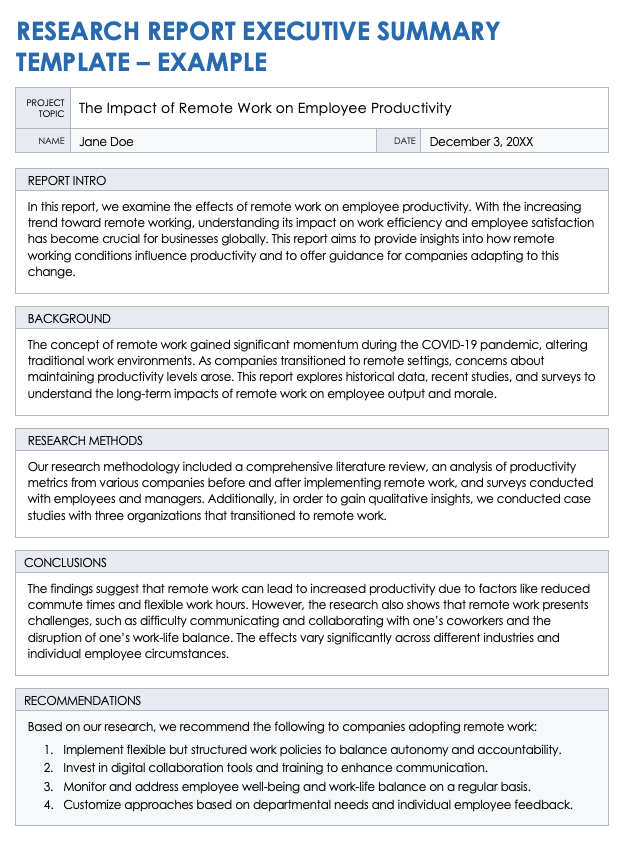
Download a Blank Research Report Executive Summary Template for
Microsoft Word | Adobe PDF | Google Docs Download an Example Research Report Executive Summary Template for
To create your own research report executive summary, download this customizable template. Available in blank and example versions and three printable formats, this template serves as a structured guide to organize and present the key components of a research report. Simply fill in each section with specific details about your research, including the project topic, background information, methods used, conclusions, and recommendations.
Research Project Proposal Executive Summary Example
An executive summary for a research project focuses mainly on the research question, methods, and expected outcomes. These summaries often point out how important the research could be and what impact it might have on the field.
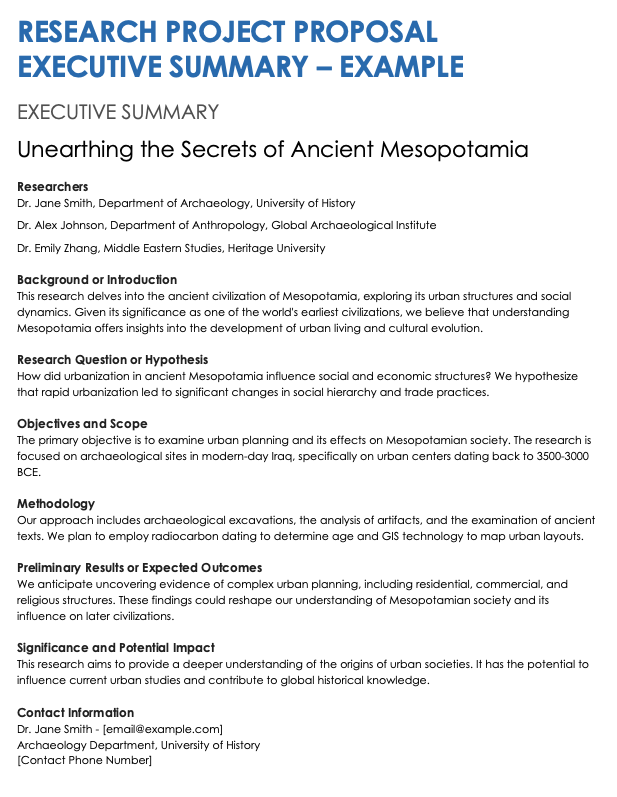
Download a Blank Research Project Proposal Executive Summary Template for Microsoft Word | Google Docs
Download an Example Research Project Proposal Executive Template for Microsoft Word | Google Docs
Teams can use this one-page executive summary — available in a blank or sample version — to concisely present the key elements of a research project to stakeholders, potential funders, or academic committees. By structuring the summary with specific sections such as background, objectives, and methodology, you can be sure that you’ve clearly and briefly outlined all critical aspects of your research.
Executive Summary Slide Example
Executive summaries are often documents that one distributes to executives, potential investors, and other stakeholders. However, slideshow presentations can facilitate a more interactive discussion. Plus, the inclusion of charts, graphs, and other images can better illustrate key points.
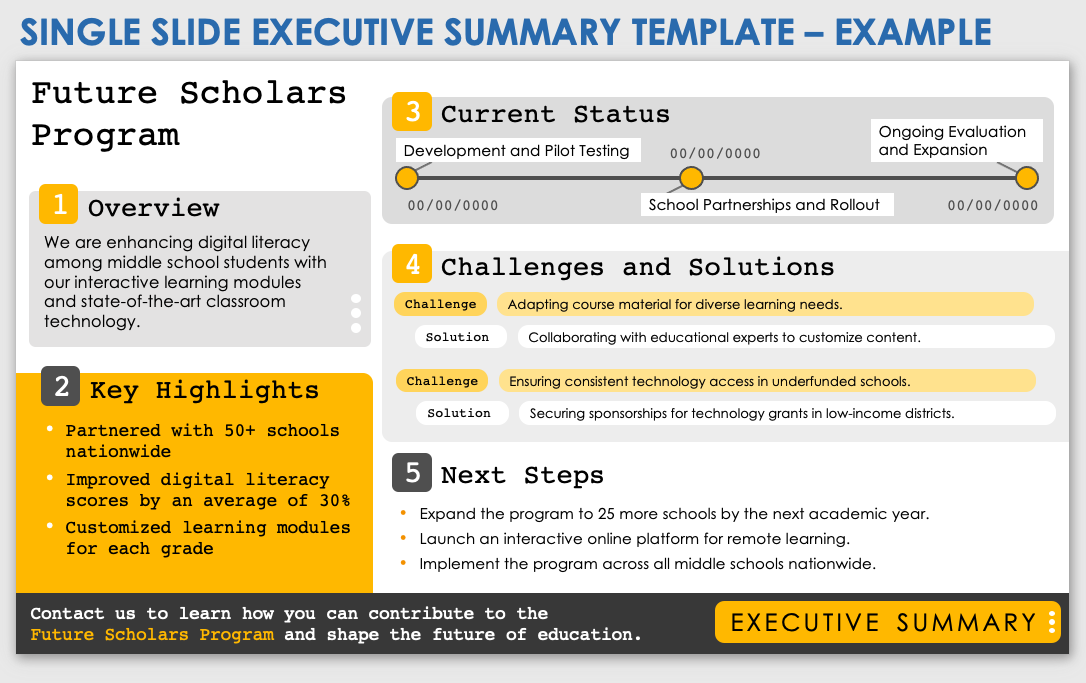
Download an Example Single Slide Executive Summary Template for
PowerPoint | Google Slides
Download a Blank Single Slide Executive Summary Template for
This executive summary slide template is a versatile tool for succinctly conveying key project information in a single, visually engaging slide. You can enter your project information in the blank template or download the sample version for additional guidance. Input relevant details in each section, such as an overview of your project and next steps. The template allows users to insert their own text, graphics, and data. Copy your completed slide into a longer presentation, or use it on its own as a visual complement to any stakeholder presentation.
How to Improve Your Executive Summary
A poorly constructed executive summary can serve as an instructive example of what to avoid. Ineffective executive summaries might be too detailed or technical, lack focus on key points, or omit a clear call to action.
Here are examples of the three most common mistakes found in executive summaries:
Includes Too Many Details or Technical Information
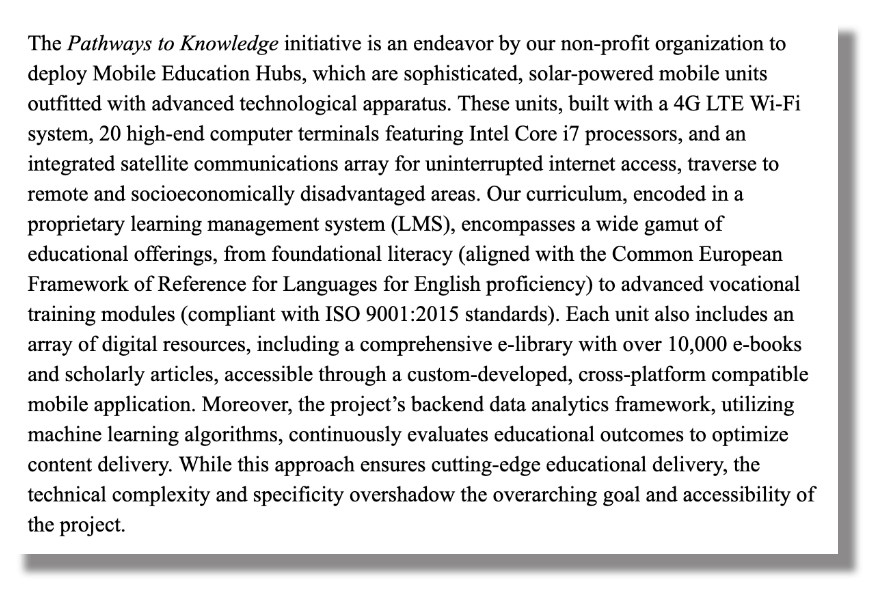
This example demonstrates one of the most common mistakes, which is including too much detail or overly technical language. It dives deeply into the specific technical specifications of the equipment and financial metrics, which might be overwhelming for readers. A more effective executive summary would focus on the broader objectives, expected impacts, and benefits of the project in a language that is accessible to a non-technical audience.
Lacks Focus on Key Points
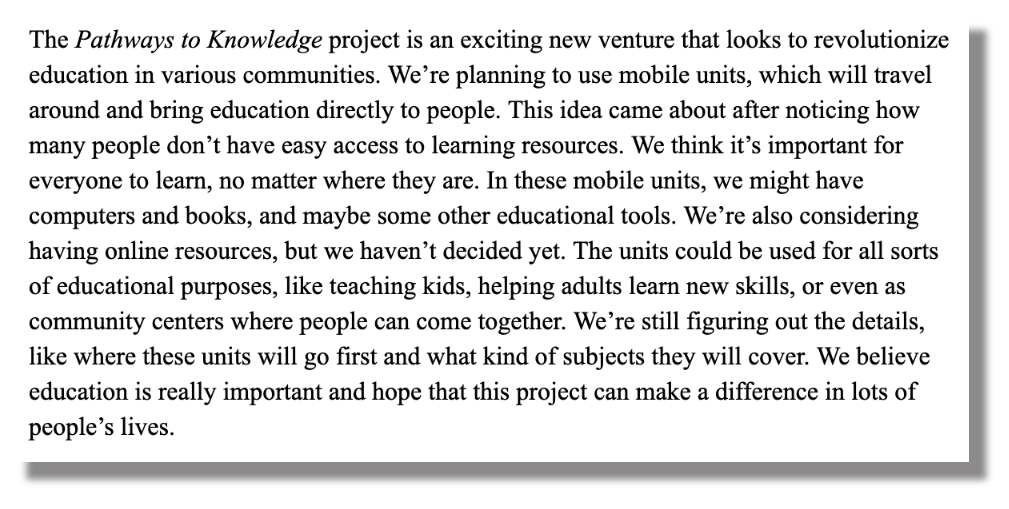
Sometimes, summaries fail to clearly highlight the most critical aspects of the project or proposal. This summary lacks focus concerning the key points of the Pathways to Knowledge project. A more effective summary would concisely state the project’s goal, significance, and anticipated outcomes.
Omits a Clear Call to Action or Conclusion
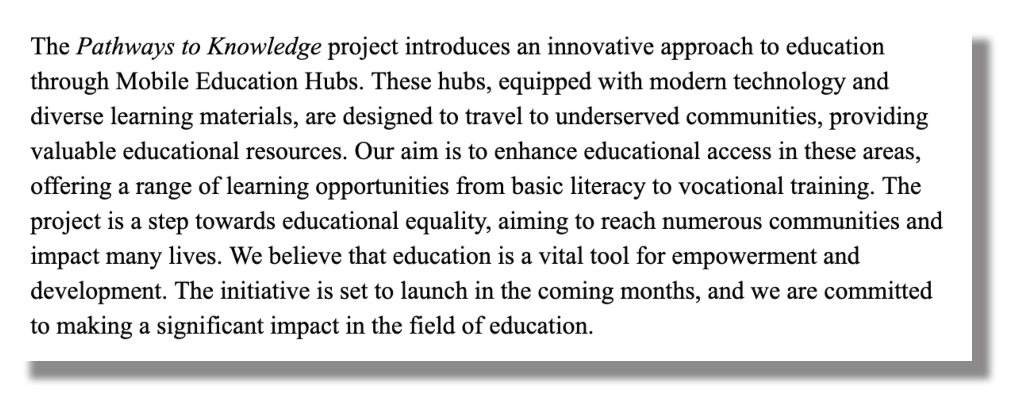
Failing to include a clear conclusion or call to action is another common mistake. The summary should not only inform but also persuade and guide the reader toward the desired action or decision. This summary outlines the project’s goals and structure, but omits a clear call to action. The document doesn’t specify what is expected from the reader or potential stakeholders, such as support, partnership, funding, or involvement in the project.
Corrected Example
To create a more effective example, start by removing overly technical details. (Stakeholders don’t need to know the specific standards with which the training modules are aligned or which types of processors power your computers.) Next, take out unnecessary details that stray from the main point of the project. An executive summary is not the place to discuss the origins of the project idea or the elements your team has not yet decided on. Finally, always conclude your executive summary with a clear call to action.
The Pathways to Knowledge project is a pioneering educational initiative by a nonprofit organization, aimed at bridging the educational divide in underprivileged and remote communities. This project involves the deployment of Mobile Education Hubs: state-of-the-art, solar-powered mobile units that are equipped with educational resources, technology, and internet access. These hubs are designed to travel to various underserved areas, providing children and adults with access to quality educational materials, online learning platforms, and virtual tutoring. Each hub also hosts workshops and seminars led by educators and experts, covering a wide range of subjects from basic literacy and numeracy to vocational training and digital literacy. The initiative seeks to empower communities by enhancing educational opportunities, fostering a culture of lifelong learning, and equipping individuals with the skills necessary for the 21st-century job market. By focusing on accessibility and adaptability, the Pathways to Knowledge project aspires to create a ripple effect of educational advancement and social upliftment across diverse communities.
Master the Art of Writing Executive Summaries with Examples for Business Plans, Project Plans, and Research Projects from Smartsheet
Empower your people to go above and beyond with a flexible platform designed to match the needs of your team — and adapt as those needs change.
The Smartsheet platform makes it easy to plan, capture, manage, and report on work from anywhere, helping your team be more effective and get more done. Report on key metrics and get real-time visibility into work as it happens with roll-up reports, dashboards, and automated workflows built to keep your team connected and informed.
When teams have clarity into the work getting done, there’s no telling how much more they can accomplish in the same amount of time. Try Smartsheet for free, today.
Discover why over 90% of Fortune 100 companies trust Smartsheet to get work done.
How to Write an Executive Summary (+ Examples)
- September 4, 2024

The executive summary is the cornerstone of any business plan, serving as a gateway for readers to understand the essence of your proposal.
It summarizes the plan’s key points into a digestible format, making it crucial for capturing the interest of investors, partners, and stakeholders.
In this comprehensive guide, we’ll explore what the executive summary is, why we use it, and also how you can create one for your business plan. Let’s dive in!
What is an Executive Summary?
An executive summary is a concise and compelling overview of a business plan (or simply a report), designed to provide readers, such as investors, partners, or upper management, with a quick and clear understanding of the document’s most critical aspects.
For a business plan, it summarizes the key points including the business overview , market analysis , strategy plan timeline and financial projections.
Typically, the executive summary is the first section of a business plan, but it should be written last to ensure it accurately reflects the content of the entire document.
The primary goal of an executive summary is to engage the reader’s interest and encourage them to read the full document.
It should be succinct, typically no more than one to two pages, and articulate enough to stand on its own, presenting the essence of the business proposal or report without requiring the reader to go through the entire document for basic understanding.
Why Do We Use It?
The executive summary plays a crucial role in whether a business plan opens doors to funding, partnerships, or other opportunities . It’s often the first (and sometimes the only) part of the plan that stakeholders read, making it essential for making a strong, positive first impression. As such, we use it in order to:
- Capture Attention: Given the volume of business plans investors, partners, and lenders might receive, an executive summary’s primary function is to grab the reader’s attention quickly. It highlights the most compelling aspects of the business to encourage further reading.
- Save Time: It provides a succinct overview of the business plan, allowing readers to understand the key points without going through the entire document. This is particularly beneficial for busy stakeholders who need to make informed decisions efficiently.
- Facilitate Understanding: An executive summary distills complex business concepts and strategies into a concise format. Therefore, it makes it easier for readers to grasp the business’s core mission, strategic direction, and potential for success.
- Driving Action: By summarizing the financial projections and funding requirements, an executive summary can effectively communicate the investment opportunity. Indeed the investment opportunity, whether to raise money from investors or a loan from a bank, is the most common reason why we prepare business plans.
- Setting the Tone: The executive summary sets the tone for the entire business plan. A well-written summary indicates a well-thought-out business plan, reflecting the professionalism and competence of the management team.
How to Write an Executive Summary in 4 Simple Steps
Here’s a streamlined approach to crafting an impactful executive summary:
1. Start with Your Business Overview
- Company Name: Begin with the name of your business.
- Location: Provide the location of your business operations.
- Business model: Briefly describe how you make money, the producfs and/or services your business offers.
2. Highlight the Market Opportunity
- Target Market : Identify your target market and its size.
- Market Trends : Highlight the key market trends that justify the need for your product or service.
- Competitive Landscape : Describe how your business is positioned to meet this need effectively.
3. Present Your Management Team
- Team Overview: Introduce the key members of your management team and their roles.
- Experience: Highlight relevant experience and skills that contribute to the business’s success.
4. Include Financial Projections
- Financial Summary: Provide a snapshot of key financial projections, including revenue, profits, and cash flow over the next three to five years.
- Funding Requirements: If seeking investment, specify the amount needed and how it will be used.
2 Executive Summary Examples
Here are 2 examples you can use as an inspiration to create yours. These are taken from our coffee shop and hair salon business plan templates.
Coffee Shop Executive Summary

Hair Salon Executive Summary

Related Posts
Waggles puppy boutique franchise fdd, profits, costs & fees (2024).
- November 27, 2024

Chatime Franchise FDD, Profits, Costs & Fees (2024)

Singas Famous Pizza Franchise FDD, Profits, Costs & Fees (2024
Privacy overview.

IMAGES
VIDEO
COMMENTS
Creating an executive summary for your business plan that is comprehensive and concise will help outline your company’s objectives. Get started here.
When introducing your business to angel investors, stakeholders, and venture capitalists, they won’t want to sit through fifty pages explaining why they should work with you. A simple and effective way to present your business in a palatable way is to write an executive summary.
To complete an executive summary for a startup commercialization plan, you need to select the right executive summary template for your startup commercialization plan. You may select from our eclectic selection of startup executive summary templates on our website.
Available in blank and example versions, this executive summary template guides you in succinctly presenting key information about your business plan or project to stakeholders. Simply fill in each section with relevant details to create a concise overview that highlights problems, solutions, market potential, product features, financials, and ...
Below is how you can write this summary for startup businesses: Discuss the business opportunity– To start with, provide a summary of the problem your business is intending to solve in the current market.
An executive summary is a concise and compelling overview of a business plan (or simply a report), designed to provide readers, such as investors, partners, or upper management, with a quick and clear understanding of the document’s most critical aspects.